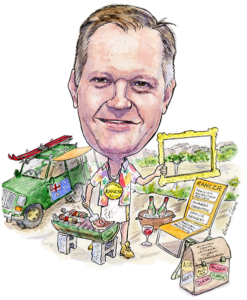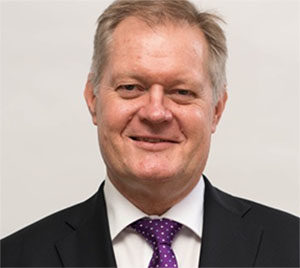 “War (as in turf war) is an emotional word because, in wars, people get hurt. I believe we truly care about the patients we serve and the last thing we want is for patients to get hurt. […] By and large, we have found that approaching role extension issues through discussion is preferable to confrontation,” Gregory John Slater, president, The Royal Australian, and New Zealand College of Radiologists (RANZCR), tells Interventional News. Slater is a radiologist at Queensland X-Ray, Brisbane, Australia, and a visiting medical officer at several private hospitals. He enjoys the outdoors, and like any true blue Aussie, loves throwing a shrimp on the barbie.
“War (as in turf war) is an emotional word because, in wars, people get hurt. I believe we truly care about the patients we serve and the last thing we want is for patients to get hurt. […] By and large, we have found that approaching role extension issues through discussion is preferable to confrontation,” Gregory John Slater, president, The Royal Australian, and New Zealand College of Radiologists (RANZCR), tells Interventional News. Slater is a radiologist at Queensland X-Ray, Brisbane, Australia, and a visiting medical officer at several private hospitals. He enjoys the outdoors, and like any true blue Aussie, loves throwing a shrimp on the barbie.
What made you choose interventional radiology?
I wanted to be a medical doctor at around 10 or 11 years of age. After that, there was no time to be wasted, it was simply a matter of getting on with it.
Having arrived in medicine, it took me much longer to yield to the siren call of interventional radiology. I was very curious about the wide spectrum of medicine and explored several specialties. I did enjoy performing procedures like cesarean sections or being a member of an open-heart surgery team, but not enough to commit to a lifetime. Then, a decade after graduating as a doctor, I resolved to commence radiology specialty training and voilà, a treasure trove of opportunity lay before me. These years were the heyday of interventional radiology as new techniques and procedures sprung everywhere. And the excitement has not waned…
Who were your mentors and what wisdom did they impart to you?
In this specialty, which relies so much on personal guidance and inspiration, mentors loom large over all our careers.
The first person to turn me on to interventional radiology was John Harper, the head of intervention at the Princess Alexandra Hospital in Brisbane. He set himself high personal standards for even simple procedures, emphasising patient safety and demanded the same from his trainees.
Ken Thomson from Royal Melbourne Hospital is a truly inspirational interventional radiologist who has had a profound effect on the lives and careers of a generation of young physicians across the Asia-Pacific region and around the world. He was truly dedicated and would never give up. I remember seeing him do a vascular case despite being badly troubled by back pain that would have confined most mere mortals to bed. Ken was so determined that he designed a frame to bear the weight of the lead gown that allowed him to work beneath the frame from the sitting position as he was unable to stand.
I was extremely fortunate to gain a two-year fellowship in abdominal imaging and intervention with Peter Mueller at Massachusetts General Hospital (MGH) in Boston, USA. Peter is one of the most inspiring teachers you would ever meet and is rightly recognised as a giant in the field.
Of all the great young interventional radiologists I met in Boston, Michael Lee, Dublin, Ireland, stands out as one who would go on to achieve great things as an innovator, teacher and leader. He has served CIRSE mightily and I will feel proud to see him awarded the Gold Medal at this year’s meeting.
Could you describe interventional radiology’s place in Australia’s healthcare system?
On the whole, interventional radiology is well established and accepted in the Australian healthcare system.
Healthcare outcomes and longevity in Australia are amongst the world’s best, yet our costs fall in the middle of the band of Organisation for Economic Co-operation and Development (OECD) countries. By and large, the health system works well.
Interventional radiology is widely available in both public and private hospitals and we generally perform similar procedures to those available overseas. For example, prostate artery embolization is now being performed at several centres, with results in line with those being achieved elsewhere. We are fortunate to have good access to medical devices without the onerous restrictions of some other countries. We have been innovative over the years and procedures such as endovascular aortic repair (EVAR) and selective internal radiation therapy (SIRT) have emanated from this country.
Many routine arterial interventions are now performed by vascular surgeons, but procedures such as embolization and thrombolysis are usually done by interventional radiologists. Interventional radiologists carry out nearly all venous interventions, except for areas such as varicose vein ablation which is shared with other specialties. Neurointerventional radiologists do almost all neurointerventional procedures in Australia.
As the 2016 president of the RANZCR, what are your goals?
 At our recent Board and Faculty Council meetings, we have decided to establish a standing committee of interventional radiology. This is our highest-level committee and aims to advance the role and place of interventional radiology in Australia and New Zealand. It aims to promote interventional radiology to the highest levels of government and the community and I expect it will seek to establish the discipline as a recognised subspecialty in our countries.
At our recent Board and Faculty Council meetings, we have decided to establish a standing committee of interventional radiology. This is our highest-level committee and aims to advance the role and place of interventional radiology in Australia and New Zealand. It aims to promote interventional radiology to the highest levels of government and the community and I expect it will seek to establish the discipline as a recognised subspecialty in our countries.
With the evidence for endovascular stroke therapy growing, I have been working with our jurisdictions and societies (Interventional Radiology Society of Australasia [IRSA] and the Australian and New Zealand Society of Neuroradiology) to determine arrangements for delivery of these services. This is a challenge in countries with relatively sparse and widely dispersed populations.
I attended the recent European Board of Interventional Radiology (EBIR) examinations held in Queenstown, New Zealand. This is the second examination series we have held, under a joint agreement between RANZCR, IRSA, and CIRSE. The examination was a great success and we are grateful to CIRSE for its support and supervision. At present this is the only EBIR examination that is held outside Europe, and we certainly aim to build on its success.
How is the challenge of turf wars tackled in Australia?
War is an emotional word because, in wars, people get hurt. I believe we truly care about the patients we serve and the last thing we want is for patients to get hurt.
The best outcome for patients is achieved when their procedure is performed by the operator with the most knowledge, training, and experience. This person will often be an interventional radiologist, but it is not automatically so. We should be aware that we do not own procedures or patients. It is inevitable that some of our procedures will be adopted by other specialty groups, and we should be proud that the procedure is sufficiently worthwhile and robust to have redefined the standard of care. It is futile to try to prevent change and sometimes it is better to be an active part of change than to rail against it.
By and large, we have found that an approach to role extension issues through meeting and discussion is preferable to confrontation. For example, we have maintained cordial relations with vascular surgeons by being involved in their conversion to endovascular surgical techniques. As long as they have the patients, it is inevitable that this would happen, but we have maintained dialogue and professional interaction going forward.
We are well aware that standards of training and certification are paramount in the definition of quality and patient outcomes. We do not accept that other operators with less skill or experience should take over a procedure, as patient outcomes would be expected to suffer. In addition to standards of training, logbooks and audit are fundamental to the defence and evaluation of our interventions. We have not always performed well here.
Finally, some of our subspecialty groups have not taken a cooperative stance with each other in role management. We should find it much easier to agree with radiologists than other specialists as we have all come through the same training programmes and have the same fundamental training and beliefs. Time wasted in internal disputes will allow other entrants to focus their resources and potentially steal a march on us.
Which aspects of interventional radiology do you foresee a strong growth for in Australia?
I am tremendously excited about the advent of interventional oncology and how it will benefit our patients. It offers the potential to stand alongside our medical, surgical and radiation oncology colleagues. It is a once-in-a-lifetime opportunity but will need to be carefully and actively managed. We will need to energetically commit to patient consultations, daily ward rounds, admitting rights, multidisciplinary teams, social media, evidence base, research, audit, and other less-familiar areas if we are truly to be regarded as clinicians. There is much we can learn from our colleagues in radiation oncology who are experts in targeting cancer.
Ablative therapy will continue to increase. There is a desperate need for robust data to support their growth potential.
Interventions for varicose veins, while quite common now, have a lot of growth potential still.
Uterine fibroid embolization has a certain following, but is much underused in Australia and New Zealand. There is a growing expectation that gynaecologists should discuss all treatment options with their fibroid patients, but this is not happening yet.
As any interventional radiologist who regularly performs percutaneous vertebroplasy knows, it is extremely effective in properly selected patients. The procedure had funding withdrawn in Australia following the trials published in the New England Journal of Medicine (NEJM) in 2009, but new evidence will hopefully restore it to being more widely used.
Musculoskeletal interventions, such as joint and bursal injections and spinal interventions for pain relief, have undergone massive growth in the last decade but are expected to grow further. Again, there is a dearth of high-quality evidence to justify large growth rates and these will come under increasing scrutiny by funders.
Prostate artery embolization should have a huge future. With the obesity epidemic, there could be a future for bariatric interventions, if they stack up.
What interesting trial data have you come across recently?
At the recent IRSA meeting in Queenstown, William Clark presented the results of the VAPOUR trial. These have just been published in The Lancet. This is an important randomised double-blinded controlled trial that provides strong evidence of the significant beneficial effects of percutaneous vertebroplasty in recent vertebral crush fractures and significant pain, both in the short-term and long-term (See Clark’s article, here).
Also at the IRSA meeting, Gerard Goh presented early experience with percutaneous arteriovenous fistula creation using two devices (everlinQ and Ellipsys). He presented the early findings of the NEAT (Novel endovascular access trial) study taking place Australia, New Zealand and Canada. The ability to successfully create an arteriovenous fistula for dialysis is a very interesting concept that could potentially have wide applicability, and the findings to date are promising.
The SIRFLOX, FOXFIRE, and FOXFIRE Global trials are prospective, open-label, multicentre randomised controlled trials comparing Y-90 spheres plus chemotherapy vs. chemotherapy alone as first-line therapy in patients with liver metastases from primary colorectal cancer, with results expected around June 2017. These, and other ongoing studies, will add further information about the value of radioembolization, and may increase its penetration.
What is the research you have carried out that you are most proud of?
The large Hypertension Unit at Greenslopes Hospital where I have worked since 1996 has a particular interest in primary aldosteronism. In radiology, we are called upon to perform large numbers of adrenal vein samplings. My colleague, Nick Daunt, and I have performed around 1,700 of these procedures between us, the largest number in the world. I hope that the published findings on technique and tips that have allowed us to increase our success rates will make the procedure a little less challenging for those who are inexperienced in it, as it can be technically difficult and has a long learning curve.
Please describe a memorable case that you treated
Of course, there are many including the patient who returned my precordial thump at the commencement of cardiopulmonary resuscitation (he was only sleeping!).
But one that stays is a female patient in her 40s with hereditary haemorrhagic telangiectasia. She had multiple nasopharyngeal telangiectases and a 30-year history of recurrent severe epistaxis and nasopharyngeal bleeds. Her life was misery as she bled for several hours each day. She required frequent hospitalisations and had required blood transfusion on hundreds of occasions. Multiple ear, nose, and throat specialists had been consulted and she had undergone many nasal cauteries and packings, but she was told that “nothing more could be done”. Remarkably, embolization had never been considered. Obviously, this was in the days before Google!
I performed a three-pillar embolization, perfectly straightforward, and she had a marvellous result. Her bleeding almost completely ceased and her life was transformed. She had a durable response and sent me a Christmas card for many years afterwards.
What is your key message to young interventional radiologists?
- If this is your calling then embrace it and go hard.
- Never abandon the patient if the outcome is suboptimal; they need your extra support and often will be very grateful for it.
- Do not skimp on research, do all you can and build relationships with your mentors.
- Remember the three “A”s that guarantee success: Able, affable and available.
Above all, do the EBIR!
What are your interests outside of medicine?
I have always enjoyed the outdoors, and enjoy camping and fishing, although my fishing boat has been sitting forlornly in the driveway for way too long.
Snow skiing has been a great love of mine since student days and has continued since my knee reconstruction 30 years ago after a fall on the long skis. Hiking is now more age-appropriate; my wife and I enjoyed walking the Routeburn Track in New Zealand earlier this year—spectacular even in the rain.
In spectator sports, I support the Wallabies rugby team, even though we lose a lot. I also follow Australian drivers in Formula One.
My love of the ballet began when doing my fellowship in Boston; it was not all work! I have a share in a small winery in the mountains with some friends and it is great to visit, pick the grapes or help the winemaker. And like any true blue Aussie, I love to throw a shrimp on the barbie!
Factfile
Education
MBBS University of Queensland
Fellow of The Royal Australian and New Zealand College of Radiologists (RANZCR)
Postgraduate training (selected)
1989–93 Registrar, Radiology, Princess Alexandra Hospital, Brisbane
1993–95 Clinical fellow in Abdominal Imaging and Interventional Radiology, Massachusetts General Hospital, Boston, USA
1995–2000 Visiting radiologist, Princess Alexandra Hospital, Brisbane
2006–07 Visiting radiologist, Princess Alexandra Hospital, Brisbane
1995–present Radiologist, Queensland X-Ray, Brisbane
1995–present Visiting medical officer, Greenslopes Private Hospital and others
Society positions (selected)
2008–12 Executive member, Council of RANZCR
2011–present Chair, Annual Scientific Meeting Committee
2012–present Member, Board of Directors, RANZCR
2016–present President, RANZCR
Honours and awards (selected)
First Class Honours, Medical School of the University of Queensland
Private Practice Research and Education Trust Fund Scholarship, Princess Alexandra Hospital, Brisbane
46th Baker Fellowship Award, Royal Australasian College of Radiologists, for further training in the field of abdominal imaging and intervention at the Massachusetts General Hospital
Honorary membership, American Roentgen Ray Society
Memberships of professional societies:
Australian Medical Association
Royal Australian and New Zealand College of Radiologists
Interventional Radiology Society of Australia
Cardiovascular and Interventional Radiology Society of Europe
American College of Radiology
American Roentgen Ray Society













